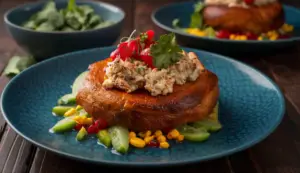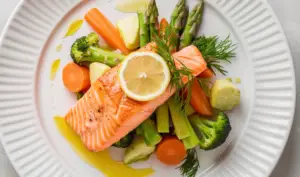introduction
Gastroesophageal Reflux Disease GERD-friendly dinners is a common digestive disorder where stomach acid frequently flows back into the esophagus, causing irritation. Managing GERD often requires dietary modifications to reduce symptoms. If you suffer from GERD, you might wonder what dinner options are both delicious and safe for you to eat. The good news is that there are plenty of meals that are not only satisfying but also gentle on your digestive system. This guide will walk you through a variety of GERD-friendly dinner ideas, offering you options that are both healthy and flavorful.
Understanding GERD and Its Triggers
GERD-friendly dinners Ideas

- Baked Chicken with Steamed Vegetables
- Ingredients: Skinless chicken breast, olive oil, salt, pepper, fresh herbs (like thyme or rosemary), and a variety of non-starchy vegetables such as broccoli, carrots, and green beans.
- Preparation:
- Preheat your oven to 375°F (190°C).
- Lightly brush the chicken breast with olive oil, and season it with salt, pepper, and fresh herbs.
- Bake the chicken for 25-30 minutes, or until it reaches an internal temperature of 165°F (74°C).
- Steam the vegetables until tender but still slightly crisp.
- Why it’s GERD-friendly: Chicken is a lean protein, which means it’s less likely to cause reflux. Steamed vegetables are easy to digest and don’t contain the fat that can trigger symptoms.
- Quinoa Salad with Grilled Turkey
- Ingredients: Quinoa, grilled turkey breast, cucumber, bell peppers, parsley, olive oil, and lemon juice.
- Preparation:
- Cook the quinoa according to package instructions.
- Grill the turkey breast, seasoned lightly with herbs and a small amount of olive oil.
- Dice the cucumber and bell peppers, and chop the parsley.
- Toss the quinoa, vegetables, and grilled turkey together, then dress with olive oil and a squeeze of lemon juice.
- Why it’s GERD-friendly: Quinoa is a whole grain that is gentle on the stomach, and turkey is a lean protein. Avoiding heavy dressings and acidic ingredients makes this meal safe and satisfying.
- Broiled Fish with Brown Rice and Asparagus
- Ingredients: Fresh white fish fillets (like cod or tilapia), brown rice, asparagus, olive oil, and mild seasoning.
- Preparation:
- Preheat the broiler in your oven.
- Lightly season the fish with olive oil and mild seasoning.
- Broil the fish for 8-10 minutes, or until the fish flakes easily with a fork.
- Cook the brown rice according to package instructions.
- Steam the asparagus until tender.
- Why it’s GERD-friendly: Fish is low in fat and high in protein, which can help minimize reflux. Brown rice is a whole grain that provides fiber without aggravating GERD symptoms.
- Vegetable Stir-Fry with Tofu
- Ingredients: Firm tofu, non-starchy vegetables (like zucchini, bell peppers, and snap peas), low-sodium soy sauce, and sesame oil.
- Preparation:
- Press the tofu to remove excess moisture, then cut it into cubes.
- Stir-fry the tofu in a small amount of sesame oil until golden brown.
- Add the vegetables and a splash of low-sodium soy sauce, cooking until the vegetables are tender-crisp.
- Why it’s GERD-friendly: Tofu is a plant-based protein that is easy on the stomach. Stir-frying in a minimal amount of oil and avoiding high-fat sauces helps prevent reflux.
- Lentil Soup with Whole-Grain Bread
- Ingredients: Lentils, carrots, celery, onions, garlic, vegetable broth, and whole-grain bread.
- Preparation:
- Sauté chopped onions, garlic, carrots, and celery in a pot until they begin to soften.
- Add the lentils and vegetable broth, bringing the mixture to a boil.
- Reduce the heat and let the soup simmer until the lentils are tender.
- Serve with a slice of whole-grain bread.
- Why it’s GERD-friendly: Lentils are a great source of protein and fiber, making this soup filling without being heavy. Whole-grain bread adds extra fiber and nutrients without triggering GERD symptoms.
Tips for Cooking GERD-friendly dinners
- Use Low-Fat Cooking Methods: Baking, grilling, steaming, and broiling are excellent ways to prepare meals that are easy on the stomach. Avoid frying foods or using excessive amounts of oil, as these can increase fat content and trigger GERD symptoms.
- Incorporate Lean Proteins: Chicken, turkey, fish, and plant-based proteins like tofu are better choices compared to high-fat meats like beef or pork. These proteins are less likely to cause heartburn and can be paired with a variety of vegetables and whole grains for a balanced meal.
- Choose the Right Carbohydrates: Whole grains like brown rice, quinoa, and whole-wheat bread provide fiber and nutrients without aggravating GERD. Avoid refined grains like white bread and pasta, which can increase stomach acid production.
- Focus on Non-Acidic Vegetables: Vegetables like broccoli, carrots, spinach, and zucchini are great options for GERD sufferers. These vegetables are low in acid and provide essential nutrients. Avoid tomatoes, onions, and garlic, which can trigger symptoms.
- Watch Portion Sizes: Eating smaller, more frequent meals can help reduce the likelihood of acid reflux. Overeating can increase pressure on the stomach, leading to acid escaping into the esophagus.
- Avoid Late Dinners: Eating close to bedtime can worsen GERD symptoms. Try to finish your dinner at least 2-3 hours before lying down to give your body time to digest properly.
Meal Planning for GERD: A Week of Dinner Ideas
Monday: Grilled chicken breast with quinoa and steamed spinach.
Tuesday: Baked salmon with brown rice and roasted Brussels sprouts.
Wednesday: Turkey and vegetable stir-fry with a side of whole-grain noodles.
Thursday: Broiled tilapia with couscous and sautéed zucchini.
Friday: Tofu and vegetable stir-fry with a side of brown rice.
Saturday: Lentil soup with a mixed greens salad and whole-grain bread.
Sunday: Roast chicken with sweet potatoes and steamed green beans.
This meal plan provides a variety of flavors and textures while staying within GERD-friendly guidelines. By rotating proteins and incorporating different vegetables and grains, you can keep your meals interesting without risking discomfort.
Frequently Asked Questions (FAQs)

1. Can I eat pasta if I have GERD?
Yes, you can eat pasta if you have GERD, but it’s best to choose whole-grain or gluten-free options, as they are less likely to cause reflux. Avoid heavy cream or tomato-based sauces, which can trigger symptoms. Instead, opt for a light olive oil-based sauce with herbs and non-acidic vegetables.
2. Are there any spices I can use that won’t trigger GERD?
While many spices can trigger GERD, some herbs and mild spices are safe. Basil, parsley, oregano, thyme, and dill are excellent choices. Ginger is also known for its digestive benefits and can be a great addition to GERD-friendly dishes.
3. Is it safe to eat dairy products with GERD?
Dairy can be a tricky category for those with GERD-friendly dinners . Low-fat or fat-free dairy products are generally safer than full-fat options. However, some people find that even low-fat dairy triggers their symptoms. It’s best to monitor your own tolerance and choose dairy alternatives like almond or oat milk if needed.
4. How can I make my meals more flavorful without triggering GERD?
Focus on fresh herbs, mild spices, and low-acid ingredients to add flavor without causing reflux. Lemon zest (not juice), low-sodium broths, and roasted garlic (used sparingly) can add depth to your dishes without increasing acid levels.
5. Can I have dessert if I have GERD?
Yes, you can enjoy dessert, but it’s important to choose options that are low in fat and acid. Fresh fruit like bananas or melons, or a small serving of a low-fat yogurt parfait, can be satisfying without causing reflux. Avoid chocolate, citrus-based desserts, and anything fried.
Conclusion
Eating dinner when you have GERD doesn’t have to be a bland or boring experience. By selecting the right ingredients and cooking methods, you can enjoy a variety of delicious and satisfying meals without triggering symptoms. Remember, the key to managing GERD is to focus on lean proteins, whole grains, and non-acidic vegetables, while avoiding known triggers like spicy foods, acidic fruits, and high-fat meals.
This approach not only helps in controlling GERD symptoms but also promotes overall health and well-being. With a little planning and creativity, you can create dinners that are both GERD-friendly dinners and enjoyable for everyone at the table. So next time you’re planning your meals, keep these tips and recipes in mind for a happy, healthy, and heartburn-free dinner experience.

